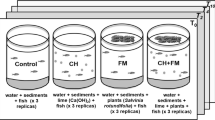Abstract
Until now, additions of lime have been used to restore the buffering capacity of acidified lakes, but an alternative method which is more effective in the treatment of lakes with organogenic sediments has recently been applied in a full-scale experiment. The method, called CONTRACID, is based on the cation exchange properties of lake sediment. A sodium carbonate (soda ash) solution is injected into the sediment (by a harrow), so that the sediment becomes sodium stocked. A reverse exchange occurs during subsequent acidification. Liming has a limited effect on humic lakes, since Ca-humates have a reduced reverse exchange ability and also the lime, which remains undissolved, is rendered inactive.
Ionic exchange processes and nutrient transport were studied in water/sediment cores andin situ enclosures after additions of soda ash-, lye- and lime solutions with subsequent re-acidification. Sodium carbonate additions in laboratory systems resulted in a sorption to the sediment of 42–62% of the added sodium ions (5 eq m−2) and a release of 14–78 mg Pm−2 sediment. Similar results were obtained in the enclosures where phosphorus release stimulated algal growth. Sediment pH, elevated by the sodium base addition, was lowered by re-acidification. Limed systems released no phosphorus and only about 25% of the added lime remained active for future neutralization. With the injection of the sodium carbonate solution into the sediment, only about 12% of the added sodium was recovered in lake water by spring circulation. Lake water alkalinity was then 0.12 meq l−1 and pH 6.7. Total phosphorus had been raised by 0.007 mg P l−1 causing an increase in phytoplankton biomass.
Observations indicate that manipulations of acidic lake sediment according to the CONTRACID method create a long-lasting neutralizing capacity and a biological stimulation (through phosphorus release), which makes the method an attractive alternative to frequent liming.
Similar content being viewed by others
References
Adamski, J. M. & Michalski, M. F. P., 1975. Reclamation of acidified lakes — Middle and Lohi, Sudbury, Ontario. Verh. int. Ver. Limnol. 19: 1971–1983.
Almer, B., Dickson, W., Ekström, C., Hörnström, E. & Miller, U., 1974. Effects of acidification in Swedish Lakes. Ambio 3: 30–36.
Beamish, R. J. & Harvey, H. H., 1972. Acidification of the La Cloche Mountain Lakes, Ontario, and resulting fish mortalities. J. Fish. Res. Bd Canada 29: 1331–1143.
Bengtsson, B., Dickson, W. & Nyberg, P., 1980. Liming acid lakes in Sweden. Ambio 9: 34–36.
Berggren, H., 1972. Sediment sampling with a core sampler. Vatten 28: 374–377 (in Swedish).
Crisman, T. L., Schulze, R. L., Brezonik, P. L. & Bloom, S. A., 1980. Acid precipitation: the biotic response in Florida lakes. Proc. Int. Conf. on the Ecological Impact of Acid Precipitation, Norway 1980, SNSF project.
DeCosta, J. & Preston, C., 1980. The phytoplankton productivity of an acidic lake. Hydrobiologia 70: 39–49.
Dickson, W., 1980. Properties of acidified waters. Proc. Int. Conf. on the Ecological Impact of Acid Precipitation, Norway 1980, SNSF project.
Dillon, P. J., Yan, N. D., Scheider, W. A. & Conroy, N., 1979. Acidic lakes in Ontario: characterization, extent and responses to base and nutrient additions. Arch. Hydrobiol. Beih. Ergebn. Limnol. 13: 317–336.
Drabløs, D. & Tollan, A. (Eds.), 1980. Ecological impact of acid precipitation. Proc. Int. Conf, Norway 1980, SNSF project.
Last, F. T., Likens, G. E., Ulrich, B. & Walløe, L., 1980. Acid precipitation — progress and problems. Conference summary. Proc. Int. Conf. on the Ecological Impact of Acid Precipitation, Norway 1980, SNSF project.
Ohle, W., 1955. Ionenaustausch der Gewässersedimente. Mem. Ist. Ital. Idrobiol., Suppl. 8: 221–245.
Ripl, W., 1976. Prozesssteuerung in geschädigten See-Ökosystemen. Vjschr. naturf. Ges. Zürich 121: 301–308.
Ripl, W. & Lindmark, G., 1979. The impact of algae and nutrient composition on sediment exchange dynamics. Arch. Hydrobiol. 86: 45–65.
Schindler, D. W., 1980. Experimental acidification of a whole lake — a test of the oligotrophication hypothesis. Proc. Int. Conf. on the Ecological Impact of Acid Precipitation, Norway 1980, SNSF project.
Schindler, D. W., Wageman, R., Cook, R. B., Ruszczynski, T. & Prokopowich, J., 1980. Experimental acidification of lake 223, experimental lakes area: background data and the first three years of acidification. Can. J. Fish. aquat. Sci. 37: 342–354.
Toth, S. J. & Ott, A. N., 1970. Characterization of bottom sediments: Cation exchange capacity and exchangable cation status. Envir. Sci. Tech. 4: 935–939.
Wright, R. F. & Gjessing, E. T., 1976. Acid precipitation: changes in the chemical composition of lakes. Ambio 5: 219–223.
Yan, N. D. & Dillon, P. J., 1981. Acidic lakes in Ontario: neutralization. Ontario Ministry of the Environment Report, Chap. 2 (in press).
Author information
Authors and Affiliations
Rights and permissions
About this article
Cite this article
Lindmark, G.K. Acidified lakes: sediment treatment with sodium carbonate — a remedy?. Hydrobiologia 91, 537–547 (1982). https://doi.org/10.1007/BF02391968
Issue Date:
DOI: https://doi.org/10.1007/BF02391968




